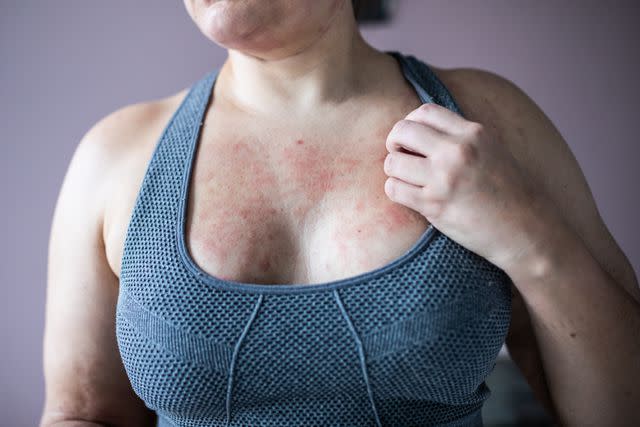Skin Cancer and Rash: When Do Symptoms Suggest Cancer?
A sore that doesn’t heal, or a rash that doesn’t go away can be signs of cancer
Medically reviewed by Marisa Garshick, MD
A rash that doesn’t heal or go away can be a sign of cancer. Skin cancer rash and leukemia petechiae, a type of rash caused by blood cancer, can cause sores or wounds that do not go away with typical treatment.
Skin cancer rash can have a variety of appearances, while cancer-related red spots on skin can cause an itchy, red rash that looks similar to contact dermatitis, allergic reaction, and other causes of rash.
Continue reading to learn how a cancer rash looks. what cancers can cause itching, and if leukemia rash comes and goes.

Tatsiana Volkava / Getty Images
How a Skin Cancer Rash Looks
Skin cancer is the most common type of cancer, and people of all skin tones can develop cancer, although people with fair skin are at the greatest risk. It has a variety of appearances and may mimic psoriasis or eczema, but doesn’t cause a widespread rash.
Most skin cancers don’t cause a widespread or itchy rash, although they can be mistaken for other skin conditions, including psoriasis. Instead, they cause a sore that doesn’t heal or go away. This sore may appear as follows:
Lumps
Bumps
Sores
Spots
Marks
Freckles or moles that changes shape or color
Basal cell carcinoma makes up 80% of skin cancers. This appears as a raised area that may be red, pink, or the color of your skin. They often—but not always—have visible blood vessels. At first, the spot may resemble psoriasis, dermatitis, or eczema. As the cancer progresses, the spot may ooze or bleed.
Anytime you have an area on your skin that is changing shape, you should see a healthcare provider. Skin cancer can take on a variety of appearances, and it’s best to get a professional opinion. Early detection is extremely important for treating skin cancer, so when in doubt, see a healthcare provider.
Other Types of Cancer and Rash
Other types of cancer, including leukemia and lymphoma, can cause widespread rashes on the skin. Here’s what those cancer-related rashes may look like.
Leukemia Petechiae
Leukemia petechiae is a rash that people with leukemia often experience on their arms, legs, or trunk. Petechiae are tiny spots that appear red, purple, or brown. They occur when a blood vessel breaks open under the skin, which happens more commonly in people with leukemia because they have a low blood platelet count.
Leukemia petechiae often resembles atopic dermatitis, a common skin rash. However, it is not typically itchy. If you press on the red spots, they will remain red, whereas most rashes that don’t involve petechiae will blanch (turn a lighter color). If you have petechiae, see your healthcare provider. Although it’s not always a sign of cancer, it can be a sign of other serious illnesses.
Lymphoma
A rare type of lymphoma (cancer of the lymphatic system) called mycosis fungoides can also cause skin rash. This rash appears as a scaly, itchy rash that may eventually cover the entire body. Symptoms of mycosis fungoides include:
Itching or pain on the skin
A flat, rash (at first)
Plaques (raised patches of skin), usually in an oval shape, that may resemble psoriasis or eczema as the rash progresses
If left untreated, this can progress to tumors on the body, and other serious symptoms of cancer, including fever, fatigue, and vision changes.
Should You Have a Provider Examine Your Rash?
In most cases rashes will resolve on their own. In some cases, they can indicate an allergy or an ongoing autoimmune condition like psoriasis or eczema. In others, they may indicate cancer.
Because skin rashes often look similar, you should see your healthcare provider if you have a rash that doesn’t go away. In particular, see a healthcare provider if your rash:
Doesn’t heal within four weeks
Looks unusual or alarming
Is accompanied by other symptoms, like fever
How to Soothe Rash Symptoms
Talk with your healthcare provider about how to soothe pain or itching associated with your rash. In many cases, treatments for itchy skin may help. These include:
Applying cool compresses
Avoiding hot baths or showers
Avoiding soaps or harsh detergents
Applying soothing lotions without dyes or fragrances
Treatments for Confirmed Skin Cancer With Rash
If your healthcare provider has confirmed a cancer diagnosis, the treatment path will depend on the type of cancer and how much it has progressed. Skin cancer treatments include removing the cancerous cells.
Treatments for other cancers, including leukemia and lymphoma, vary widely and depend on your cancer, its staging, and your health history. It’s important to find a treatment team that you trust, and always ask for a second opinion regarding any major medical decisions or treatment options.
Treatment Effectiveness and Prognosis
Like your course of treatment, the effectiveness and your long-term prognosis will vary widely based on the type of cancer and how far it has spread. Talk with your team, and ask them questions about your long-term health.
Remember, although cancer is a less common cause of a skin rash, early treatment is very important. If you’re concerned about a cancer-related skin rash, call your healthcare provider.
Summary
A rash that doesn’t heal or go away can be a sign of cancer. Skin cancer causes painful ulcers or growths that may be mistaken for psoriasis or eczema. These rashes are often in one spot. Other cancers, including leukemia and lymphoma, can cause red, sometimes itchy rashes on the trunk and limbs.
Anytime you have a rash that doesn’t go away after four weeks, see your healthcare provider. Early detection is very important for treating cancer and achieving the best possible prognosis.
Read the original article on Verywell Health.

